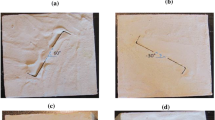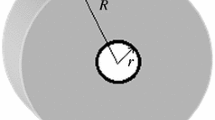Abstract
In this research, the breakage behavior of rock pillars under the uniaxial compressive strength test is investigated using both experimental and three-dimensional discrete element methods. Gypsum samples with rectangular and hourglass hexagonal shapes are constructed to simulate underground mine pillars. Within the samples, various settings of created holes in different angles, numbers, and shape patterns are considered to design a total of 20 configurations for the failure test. Twelve layouts included horizontal rows of 5 holes (1, 2, or 3 rows) at different angles (0°, 30°, 60°, and 90°). The hole patterns in the other 8 arrangements involved some usual geometric shapes including vertical ellipse, vertical rectangle, triangle, horizontal ellipse, horizontal rectangle, diamond, trapezoid, and square. For the experimental tests, 60 specimens are prepared (3 samples for each configuration to increase reliability). For the PFC3D simulations, 20 models with similar setups are prepared to replicate the experiments. The loading rate was set to 0.016 m/s. Our results show that the hole parameters, i.e., angles, numbers, and shape configurations, are the key factors in the failure process. Our analysis helps reveal a correlation between the breakage pattern, the breakage mechanism of discontinuities, and the maximum applied force of the specimens. Increasing the hole angles and numbers add to the total crack number (TCN). The minimum load-carrying capacity of the samples is recorded for the sample with 15 holes at 30° and 60° angles.








Similar content being viewed by others
References
Cook NGW (1976) Seismicity associated with mining. Eng Geol 10:99–122. https://doi.org/10.1016/0013-7952(76)90015-6
Esterhuizen GS (2000) “Jointing Effects on Pillar Strength” in 19th International Conf. In: Morgantown WV (ed) on Ground Control in Mining. University of West Virginia, pp 286–290
Esterhuizen, GS, Dolinar, DR, Ellenberger, JL, Prosser, LJ (2011) Pillar and roof span design guidelines for underground stone mines. pittsburgh, PA: U.S. department of health and human services, centers for disease control and prevention, National Institute for Occupational Safety and Health, DHHS (NIOSH) Publication No. 2011–171, IC 9526, 2011 May :1–64. http://www.cdc.gov/niosh/mining/works/coversheet1355.html
Fang Z, Harrison JP (2002) Numerical analysis of progressive fracture and associated behaviour of mine pillars by use of a local degradation model. Trans Instn Min Metal 111:59–72. https://doi.org/10.1179/mnt.2002.111.1.59
Protosenya A, Verbilo P (2016) Forecast jointed rock mass compressive strength using a numerical model. MATEC Web Conf 73:04006
Martina CD, Maybee WG (2000) The strength of hard-rock pillars. Int J Rock Mech Min Sci 37:1239–1246. https://doi.org/10.1016/S1365-1609(00)00032-0
Yang TH, Wang PT, Xu T, Yu QL, Zhang PH, Shi WH, Hu GJ (2015) Anisotropic characteristics of fractured rock mass and a case study in Shirengou Metal Mine in China Tunn. Undergr Space Technol 48:129–139
Yang S-Q, Chen M, Huang Y-H, Jing H-W, Ranjith P (2020) An experimental study on fracture evolution mechanism of a non-persistent jointed rock mass with various anchorage effects by DSCM, AE and X-ray CT observations. Int J Rock Mech Min Sci 134:104469
Sarfarazi V, Abharian S, Ghorbani A (2021) Physical test and PFC modelling of rock pillar failure containing two neighboring joints and one hole. Smart Struct Syst 27(1):123–137. https://doi.org/10.12989/sss.2021.27.1.123
Zhang C, Zhao Y, Han P, Bai Q (2022) Coal pillar failure analysis and instability evaluation methods: a short review and prospect. Eng Fail Anal 138:106344. https://doi.org/10.1016/j.engfailanal.2022.106344
Luo S, Gong F (2023) Evaluation of energy storage and release potentials of highly stressed rock pillar from rockburst control perspectives. Int J Rock Mech Min Sci 163:105324. https://doi.org/10.1016/j.ijrmms.2022.105324
Bahaaddini M, Sharrock G, Hebblewhite BK (2013) Numerical investigation of the effect of joint geometrical parameters on the mechanical properties of an on-persistent jointed rock mass under uniaxial compression. Comput Geotech 49:206–225
Ranjith PG, Fourar M, Pong SF, Chian W, Haque A (2004) Characterization of fractured rocks under uniaxial loading states. Int J Rock Mech Min Sci 41:43–48. https://doi.org/10.1016/j.ijrmms.2004.03.017
Khani A (2013) Numerical investigation of the effect of fracture intensity on deformability and REV of fractured rock masses. Int J Rock Mech Min Sci 63:104–112. https://doi.org/10.1016/j.ijrmms.2013.08.006
Kulatilake H, Stephansson O (1994) Effect of finite size joints on the deformability of jointed rock at the two-dimensional level. Can Geo Tech J 31:364–374. https://doi.org/10.1139/t94-044
Coli N, Berry P, Boldini D (2011) In situ nonconventional shear tests for the mechanical characterization of a bimrock. Int J Rock Mech Min Sci 48:95–102. https://doi.org/10.1016/j.ijrmms.2010.09.012
Halakatevakis N, Sofianos A (2010) Strength of a blocky rock mass based on an extended plane of weakness theory. Int J Rock Mech Min Sci 47(4):568–582. https://doi.org/10.1016/j.ijrmms.2010.01.008
Hoek E, Brown ET (1997) Practical estimates of rock mass strength. Int J Rock Mech Min Sci 34(8):1165–1186. https://doi.org/10.1016/S1365-1609(97)80069-X
Palmstrom A, Singh R (2001) The deformation modulus of rock masses: comparisons between in situ tests and indirect estimates. Tunnel Undergr Space Technol 16:115–131. https://doi.org/10.1016/S0886-7798(01)00038-4
Özkan İ, Erdem BÜLENT, Ceylanoğlu A (2015) Characterization of jointed rock masses for geotechnical classifications utilized in mine shaft stability analyses. Int J Rock Mech Min Sci 73:28–41. https://doi.org/10.1016/j.ijrmms.2014.10.001
Sarfarazi V, Abharian S, Ghalam EZ (2021) Physical test and PFC2D simulation of the failure mech-anism of echelon joint under uniaxial compression. Comput Concrete 27(4):99–109. https://doi.org/10.12989/cac.2021.27.2.099
Haeri H, Sarfarazi V (2016) The effect of micro pore on the characteristics of crack tip plastic zone in concrete. Comput Concrete Int J 17(1):107–112. https://doi.org/10.12989/cac.2016.17.1.107
Sarfarazi V, Faridi HR, Haeri H, Schubert W (2016) A new approach for measurement of anisotropic tensile strength of concrete. Adv Concrete Constr Int J 3(4):269–284. https://doi.org/10.12989/acc.2015.3.4.269
Sarfarazi V, Haeri H, Shemirani A, Zhu Z (2017) Shear behavior of non-persistent joint under high normal load. Strength Mater 49:320–334. https://doi.org/10.1007/s11223-017-9872-6
Yang JP, Chen WZ, Yang DS, Yuan JQ (2015) Numerical determination of strength and deformability of fractured rock mass by FEM modeling. Comput Geotech 64:20–31. https://doi.org/10.1016/j.compgeo.2014.10.011
Yaylaci M (2016) The investigation crack problem through numerical analysis. Struct Eng Mech Int J 57(6):1143–1156. https://doi.org/10.12989/sem.2016.57.6.1143
Yaylacı M, Birinci A (2015) Analytical solution of a contact problem and comparison with the results from FEM. Struct Eng Mech Int J 54(4):607–622. https://doi.org/10.12989/sem.2015.54.4.607
Lin Q, Cao P, Cao R, Lin H, Meng J (2020) Mechanical behaviour around double circular openings in a jointed rock mass under uniaxial compression. Arch Civil Mech Eng 20(1):19. https://doi.org/10.1007/s43452-020-00027-z
Yaylaci M, Avcar M (2020) Finite element modeling of contact between an elastic layer and two elastic quarter planes. Comput Concrete Int J 26(2):107–114. https://doi.org/10.12989/cac.2020.26.2.000
Min KB, Jing L (2003) Numerical determination of the equivalent elastic compliance tensor for fractured rock masses using the distinct element method. Int J Rock Mech Min Sci 40(6):795–816. https://doi.org/10.1016/S1365-1609(03)00038-8
Esmaieli K, Hadjigeorgiou J, Grenon M (2010) Estimating geometrical and mechanical REV based on synthetic rock mass models at Brunswick Mine. Int J Rock Mech Min Sci 47(6):915–926. https://doi.org/10.1016/j.ijrmms.2010.05.010
Ivars DM, Pierce ME, Darcel C, Reyes-Montes J, Potyondy DO, Young RP, Cundall PA (2011) The synthetic rock mass approach for jointed rock mass modelling. Int J Rock Mech Min Sci 48(2):219–244. https://doi.org/10.1016/j.ijrmms.2010.11.014
Wang P (2016) Numerical analysis on scale effect of elasticity, strength and failure patterns of jointed rock masses. Geosci J 20(4):539–549. https://doi.org/10.1007/s12303-015-0070-x
Zhang G, Li Y, Shi X, Yang C, Wang L (2011) Research on a model material preparation method for alternate layered rock mass and preliminary experiment. Rock Soil Mech 32(2):284–289
Yang L, Sharafisafa M, Shen L (2021) On the fracture mechanism of rock-like materials with interbedded hard-soft layers under Brazilian tests. Theor Appl Fract Mech 116:103102. https://doi.org/10.1016/j.tafmec.2021.103102
Golewski GL (2023) (2023a) Mechanical properties and brittleness of concrete made by combined fly ash, silica fume and nanosilica with ordinary Portland cement. AIMS Mater Sci 10(3):390–404
Golewski GL (2023b) Concrete composites based on quaternary blended cements with a reduced width of initial microcracks. Appl Sci 13(12):7338. https://doi.org/10.3390/app13127338
Golewski GL (2023c) The phenomenon of cracking in cement concretes and reinforced concrete structures: the mechanism of cracks formation, causes of their initiation, types and places of occurrence, and methods of detection—a review. Buildings 13(3):765. https://doi.org/10.3390/buildings13030765
Golewski GL (2023d) Effect of coarse aggregate grading on mechanical parameters and fracture toughness of limestone concrete. Infrastructures 8(8):117. https://doi.org/10.3390/infrastructures8080117
Abharian S, Sarfarazi V, Fatehi Marji M, Rasekh H (2022) Experimental and numerical evaluation of the effects of interaction between multiple small holes and a single notch on the mechanical behavior of artificial gypsum specimens. Theor Appl Fract Mech. https://doi.org/10.1016/j.tafmec.2022.103462
Potyondy DO (2012) A flat-jointed bonded-particle material for hard rock. Paper presented at the 46th U.S. Rock Mechanics/Geomechanics Symposium, Chicago, USA
Ghazvinian A, Sarfarazi V, Schubert W, Blumel M (2012) A study of the failure mechanism of planar non-persistent open joints using PFC2D. Rock Mech Rock Eng 45(5):677–693. https://doi.org/10.1007/s00603-012-0233
Sarfarazi V, Abharian S, Babanouri N, Salari rad H (2021) Interaction between a hole and a crack in different layouts: experimental and numerical study on concrete. Comput Concrete 28(4):415–432. https://doi.org/10.12989/cac.2021.28.4.415
Author information
Authors and Affiliations
Contributions
VS contributed to supervision, formal analysis, validation, and software. JF contributed to visualization and investigation. HH contributed to data curation, validation, software, and writing—original draft preparation; SA contributed to visualization, investigation, and software; HR contributed to software and investigation; MB contributed to investigation; MFM contributed to writing—reviewing and editing.
Corresponding author
Ethics declarations
Conflict of interest
The authors have no conflicts of interest to declare that are relevant to the content of this article.
Additional information
Publisher's Note
Springer Nature remains neutral with regard to jurisdictional claims in published maps and institutional affiliations.
Rights and permissions
Springer Nature or its licensor (e.g. a society or other partner) holds exclusive rights to this article under a publishing agreement with the author(s) or other rightsholder(s); author self-archiving of the accepted manuscript version of this article is solely governed by the terms of such publishing agreement and applicable law.
About this article
Cite this article
Sarfarazi, V., Fu, J., Haeri, H. et al. Mechanical characteristics and crack propagation mechanism in rectangular and trapezoidal specimens of excavated pillars with various cavities: experimental and numerical investigations. Comp. Part. Mech. (2024). https://doi.org/10.1007/s40571-024-00752-9
Received:
Revised:
Accepted:
Published:
DOI: https://doi.org/10.1007/s40571-024-00752-9




